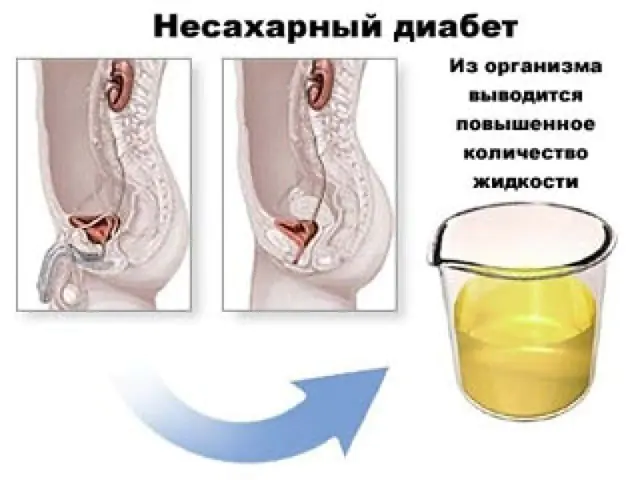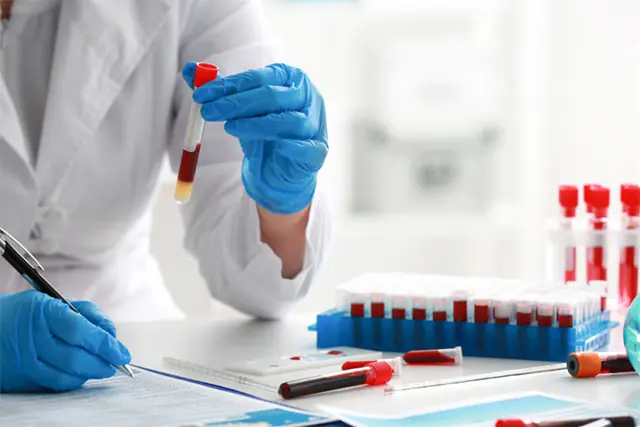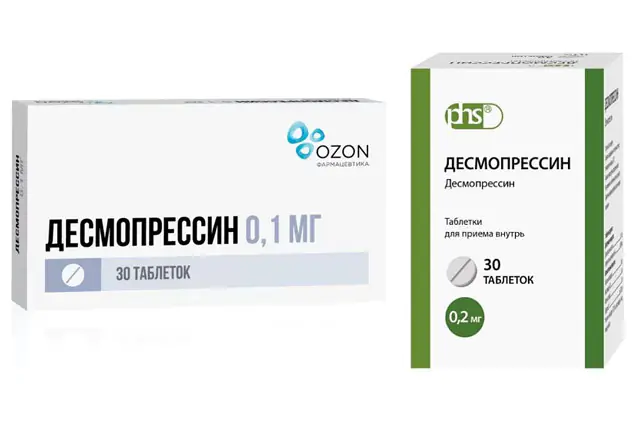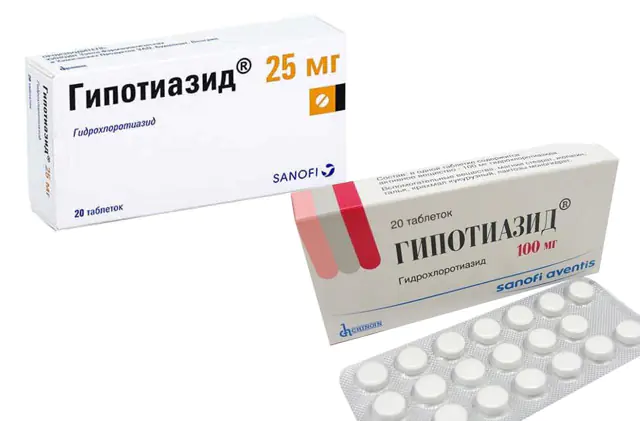
Causes of the disease, signs and symptoms of diabetes insipidus. Diagnosis and treatment methods for various forms of pathology. Recommendations for patients with diabetes insipidus.
The content of the article:- Causes of diabetes insipidus
- Main symptoms
- Diagnostics
- Treatment of diabetes insipidus
- Central form
- Peripheral form
- Recommendations
Diabetes insipidus is a hormonal disease in which the level of antidiuretic hormone (vasopressin) secreted by the hypothalamus is sharply reduced. The term “diabetes” means “diabetes”, because this is the main symptom of the disease, but since there is no glucose in the urine, the disease is called diabetes insipidus. The pathology is rare; according to some data, among all hormonal disorders its frequency is less than 1%. Young people get sick, most often between 20 and 40 years old. The incidence is the same in both sexes.
Causes of diabetes insipidus

A deficiency of antidiuretic hormone (ADH) can be absolute if its production in the hypothalamus does not occur at all or is very small. But there is also a relative deficiency of ADH, when its amount is normal, but the tissues lose sensitivity to it.
There are also central and peripheral diabetes insipidus, the causes of which are different. The central variant is associated with the pathology of the hypothalamic-pituitary system, that is, with the place where ADH is released into the blood, and the peripheral one with the organ on which this hormone acts, that is, the kidneys.
The central form of diabetes insipidus with absolute ADH deficiency can be caused by the following reasons:
- Infection. Inflammation of the hypothalamus-pituitary gland zone during viral infections affecting the central nervous system, tuberculosis, whooping cough, scarlet fever. Some intestinal infections, such as typhoid and paratyphoid, also tend to affect this area of the brain. Among sexually transmitted infections, syphilis can be the cause.
- Traumatic brain injury. With a concussion, bruise and hemorrhage in the hypothalamus-pituitary gland zone, tissue nutrition is disrupted, as a result, some of the cells that produce ADH die.
- Autoimmune diseases. Destruction can occur when the hypothalamus and pituitary gland are damaged by the body's immune cells.
- Tumors. Compression of the pituitary gland and hypothalamus can occur with a tumor of the pituitary gland itself (adenoma), with a tumor of brain tissue (craniopharyngioma, meningioma, glioma) and with metastases to the brain from cancer of another organ (breast, lung).
- Surgical intervention. Any operation in the area of the hypothalamus and pituitary gland carries the risk of partial damage to the vessels supplying the pituitary gland or the hormone-producing cells themselves.
- Pathology of cerebral vessels. Impaired blood circulation and compression of the pituitary gland also occurs with an aneurysm of the cerebral vessels of the hypothalamus-pituitary gland zone.
- Endocrine diseases. Diabetes insipidus develops as a symptom of Cushing's disease, Simmonds' disease, Sheen's disease, and adipose-genital dystrophy.
- Granulomatous diseases. In sarcoidosis and histiocytosis, bumps of immune cells form in the tissues.
Difficult childbirth is also considered to be the cause of the development of the central form of diabetes insipidus.
The peripheral or relative form develops against the background of normal ADH levels and is associated with “ignoring” the hormone by the renal tubules. This option is called nephrogenic diabetes insipidus.
Nephrogenic diabetes insipidus can be:
- Congenital. This diabetes insipidus occurs in men and is inherited along with the X chromosome (female chromosome). Women do not develop this form because the female sex has a “spare” X chromosome.
- Acquired. It is caused by damage to the renal tubules in certain diseases (amyloidosis, sarcoidosis), intoxication with lithium and methoxyflurane, as well as potassium deficiency and hyperparathyroidism.
These forms predominate in women and children. In children in the first year of life, the so-called functional diabetes insipidus develops. It is associated with a not yet very developed system of response of the renal tubules to antidiuretic hormone and a high level of an enzyme that “disables” receptors (sensitive nerve endings) for vasopressin, so the effect of the hormone does not last long.
Pregnant women develop gestagenic diabetes insipidus. The placenta, which functions from the second trimester of pregnancy, is capable of secreting a substance that inactivates ADH. After childbirth, all symptoms disappear.
Sometimes doctors do not find any objective reason; in this case, the pathology is called idiopathic diabetes insipidus.
ADH levels decrease when:
- low sodium levels;
- an increase in the level of fluid in the vascular bed and in the extracellular fluid;
- high blood pressure;
- decrease in body temperature;
- taking certain medications (beta-blockers, glucocorticosteroids, alcohol, morphine, reserpine, diphenine and chlorpromazine).
Long-term use of diuretics impairs the sensitivity of the tubules, which also causes the development of diabetes insipidus, which is called iatrogenic (caused by medical intervention).
Main symptoms of diabetes insipidus

ADH deficiency is the reason for the lack of its effects in the body. ADH has two main actions: it reduces the level of urine excreted by acting on the kidneys, and it constricts blood vessels. Therefore, it is called antidiuretic hormone, which literally means “hormone against diuresis,” and the second name is “vasopressin,” that is, “pressing blood vessels” (“vase” - “vessel”). The greater the ADH deficiency, the more severe diabetes insipidus and the more severe its symptoms.
Diabetes insipidus causes the following symptoms:
- Excessive urination (polyuria). Due to the lack of a water-retaining effect, the renal tubules pass almost all of the liquid portion of the blood into the urine. A sick person is constantly forced to empty the bladder, and the amount of fluid released can be quite large.
- Intense thirst (polydipsia). The more urine is released, the stronger the feeling of thirst. A person can drink more than 10 liters of water per day.
- Signs of dehydration. Due to a decrease in the amount of intracellular fluid, patients complain of a lack of saliva, sweat, dry mouth and dry skin. In severe dehydration, if the volume of lost fluid is not replenished, severe weakness, headache, anxiety, and irritability appear. The patient feels nauseous and may experience slight vomiting. Body temperature gradually rises, convulsions occur, heart rate increases, and blood pressure drops.
- Poor digestion. Forced consumption of large amounts of liquid leads to a sharp expansion of the stomach. Fluid deficiency is also manifested by a decrease in the production of gastric juice, which is why gastritis with low acidity develops. Poor processing of food in the stomach and intestines leads to chronic constipation.
Diabetes insipidus in children is manifested by retardation in growth, as well as in physical and sexual development. Very young children become whiny.
Depending on the severity of the condition, the following degrees of diabetes insipidus are distinguished:
- mild - in the absence of treatment, a person loses 6-8 liters of fluid in urine per day;
- average - up to 14 liters are lost per day without treatment;
- severe - daily diuresis is more than 14 liters.
Diagnosis of diabetes insipidus

If diabetes insipidus is suspected, diagnosis is carried out according to a scheme that includes examination of the patient, analysis of his complaints and clarification of the diagnosis using laboratory tests. When talking with the patient, it also turns out that the urine has become completely light, and the urge to urinate occurs both at night and during the day. Urinary incontinence often develops, especially at night; children, for example, urinate directly in the bed.
Examination reveals the general irritable state of the patient; less often he is lethargic and apathetic. The doctor notes a fast pulse, low blood pressure, very dry mucous membranes and skin.
When diagnosing the disease, the following are prescribed:
- General blood analysis — reveals blood thickening (the number of cellular elements is greater compared to the liquid part);
- General urine analysis — there is a low density of urine (it is too diluted) ranging from 1001 to 1004 kg/l;
- Blood chemistry - high levels of sodium, more than 155 meq/l (normally, ADH reduces its level), creatinine and urea and plasma osmolarity more than 290 mOsm/kg (increases with blood thickening);
- Blood test for ADH - in the blood itself, you can determine the amount of antidiuretic hormone, which in the case of an absolute deficiency is reduced, in the peripheral version it can be not only normal, but also increased.
To assess kidney function, a Zimnitsky test is also prescribed.
Important! Instrumental methods make it possible to identify some causes of diabetes insipidus, but the disease itself is diagnosed by the level of hormones in the blood and with the help of tests.Computed tomography (CT) and magnetic resonance imaging (MRI) scans of the brain look for tumors that interfere with ADH production. To diagnose the hereditary causes of the pathology, the patient is offered to undergo genetic analysis.
Strong thirst can also be of a psychogenic nature and in diabetes mellitus. The psychogenic variant is sometimes called dipsogenic diabetes insipidus, but its cause is not associated with ADH deficiency or kidney pathology. To distinguish the peripheral variant of diabetes insipidus from psychogenic thirst, tests are carried out.
Differential diagnosis is carried out using the following tests:
- Dry food test. The patient is deprived of fluid for 6-8 hours. The test is only carried out in the hospital, because every hour you need to collect urine and measure its density and quantity. In case of diabetes insipidus, this regimen sharply worsens the well-being of the test subject, the amount of fluid secreted by the kidneys does not decrease, all analysis parameters remain the same as before the test. If this is psychogenic thirst, then due to fluid deprivation the patient does not get worse, but more urine is released, and the density level reaches normal values.
- Test with hypertonic sodium chloride solution. A 2.5% soda solution is administered intravenously over 45 minutes. A catheter is inserted into the bladder through which urine is collected every 15 minutes. The purpose of the test is to increase plasma osmolarity. Normally, this stimulates the release of ADH, so if the hormone is deficient, the test is negative - osmolarity does not change. If all complaints are related to psychogenic thirst, the ADH level increases, which is manifested by increased fluid secretion from the body and increased urine density. This is considered a positive test.
- Test with diuretics. The patient is given a hypothiazide tablet (100 mg) to drink. This drug can cause a paradoxical effect in case of absolute hormone deficiency - reduce fluid loss in the urine and increase its density. The test is negative for psychogenic thirst.
Blood and urine tests help differentiate between diabetes mellitus and diabetes insipidus. With diabetes, the level of glucose in the blood is sharply increased, and the density of urine is increased.
Treatment methods for diabetes insipidus

The disease is treated by an endocrinologist. This specialist chooses how to treat diabetes insipidus depending on its form. The patient is recommended to correct dehydration, eliminate the cause of the disease, and at the same time undergo an examination either in a hospital or in a clinic. In severe cases of the disease, monitoring of the amount of fluid drunk and excreted, the general condition of the body will be required, and in some cases surgery will be prescribed, so the patient will be hospitalized.
Treatment of the central form of diabetes insipidus
Central diabetes insipidus requires treatment of the underlying pathology of the hypothalamus and pituitary gland. For infections, antibiotics are prescribed. If the hormone deficiency is caused by a tumor or secondary pathology of the endocrine system, then surgery or elimination of the pathology of another gland may be performed to relieve the person of symptoms. At the same time, surgery does not guarantee that hormone levels will return to normal values.
The operation is performed by a neurosurgeon using radiation or endoscopic removal of a tumor from the hypothalamus-pituitary gland zone. After the intervention there is a recovery period, during which you will still have to take hormones.
Desmopressin is used as a replacement therapy drug. Its analogues are Minirin, Presaynex. The drugs are used in the form of tablets and nasal spray. The price for a package of tablets is 1200-3500 rubles (500-1500 hryvnia), depending on the dose and country of origin of the drug. The cost of the spray is 2500-3700 rubles (1000-1500 hryvnia).
With the central form, most patients require long-term hormone replacement therapy. This means that the patient will take the hormone from outside throughout his life, since the body itself cannot secrete it in sufficient quantities.

Treatment of peripheral diabetes insipidus

In the photo, hypothiazide 25 and 100 mg for the treatment of peripheral diabetes insipidus
Nephrogenic diabetes insipidus does not provide comprehensive treatment that can rid a person of this disease forever. Symptomatic therapy is prescribed, that is, aimed at eliminating the symptoms, and not the causes of hormonal imbalance.
Of the effective drugs for this form, only the group of thiazide diuretics is suitable. Their main representative is Hypothiazide. A structural analogue of the drug is Hydrochlorothiazide. The price for a package of tablets varies from 44 to 133 rubles (20-55 hryvnia).
Despite the fact that it is a diuretic, in diabetes insipidus the drug has the opposite antidiuretic effect. This paradoxical effect is due to the fact that Hypothiazide reduces the amount of water that enters the distant parts of the renal tubules, where ADH acts. As a result, less water gets into the power of the ADH than usual.
A side effect of the drug is loss of potassium in the urine, so the potassium-sparing diuretic Triamterene is additionally prescribed. There are no structural analogues. Other drugs in the group of potassium-sparing diuretics, such as Veroshpiron, Spironolactone, are not used.
Triamterene is part of a combination drug that simultaneously contains Hypothiazide - Triampur Compositum. Analogues - Triamtel, Diazid, Diuretidin. The average price per package is 300-500 rubles (125-210 hryvnia).
Recommendations for patients with diabetes insipidus

With a slight deficiency of ADH, diabetes insipidus can be eliminated using doctor's recommendations. The purpose of patient advice is to prevent the development of dehydration. If you drink more fluids throughout the day (more than 2.5 liters), dehydration and associated symptoms can be prevented. The principle of free drinking also applies - drink as much as you want.
With the central form, it is not necessary to follow a diet. The peripheral option requires that the food be rich in potassium; the amount of salt will have to be reduced.
For severe diabetes, it is recommended to wear cards or bracelets that indicate the diagnosis. This is necessary so that doctors or people providing first aid know about the patient’s condition and do not waste time searching for the cause of a sharp deterioration in health, but immediately administer the necessary drug to the person.
What is diabetes insipidus - watch the video:



